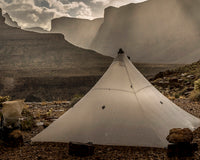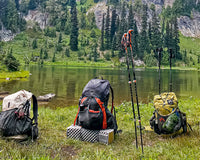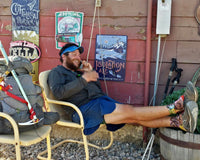
On my first thru-hike, night hiking was a novelty. It was something we did to see the stars, or to cross the Mojave Desert. I was comfortable with it, but it wasn’t a common practice. We did it as a group, a marching parade of headlamps down the Pacific Crest Trail.
But, in the last ten years, as I have taken on bigger and bigger projects, night hiking has become common practice. And, it isn’t always done to log more miles, or as a strategy to set a record.
Nature at night is a different experience. The trails are clear of people, different animals are around, and the endless expanse of the universe is visible directly overhead. It didn’t happen overnight, but I have come to love what hiking in the dark offers.
Here are a few for how to make the most out of the experience!
Slow Down

Even on familiar trails, my pace at night is slower. Each rock, root, and obstacle is easier to miss, and the solitary beam of my headlamp can only illuminate the trail so much.
Last winter, while training for the Barkley Marathons, I ran the same mile stretch of trail that gained 1,700 feet of elevation over and over again, but my pace at night always paled in comparison to what I could do during the day. It was not that I didn’t know every inch of the trail, but more that my comfort level was at a slower pace.
At night it is important to accept that everything is slower. Whether it is finding an item in a backpack, finding the right route at a trail intersection, or simply walking down a trail, night hiking is just slower.
Gear

Maggie and I recently hiked the Ouachita Trail and she started out with a headlamp that simply was not powerful enough to comfortably illuminate the trail. At full power, it died within an hour and at low power, she could not see well enough to hike.
Having the right gear to hike at night makes the difference between a comfortable experience and a frustrating one.

Gear does not begin and end at illumination. The temperature is cooler at night, the wind can unexpectedly pick up, and batteries drain much quicker. Being prepared with excess layers, gloves, and battery power can go a long way in aiding successful night hiking.
On the Colorado Trail Record I carried two headlamps: one battery powered and one rechargeable. Despite wanting to cut as much weight as I could for nine unsupported days, I was willing to carry the backup to ensure there was no obstacle in logging night miles.
Double Check Twice

On the Continental Divide Trail, I was hiking in the dark trying to camp right at the crossing of the Adams Fork of the Conejos River. I dropped down to the river and followed the trail just waiting for when it turned to the right and crossed the flowing water. That would be my camp spot. Thirty minutes went by, and then an hour, but the crossing never came.
It was cold and I was avoiding opening up my phone to conserve battery, but eventually I took my pack off and sat down to see how much further until my river crossing. As soon as my location showed up, I realized I had walked three miles down the wrong trail. By neglecting to double-check along the way, I had wasted two good hours of night hiking.
Also, always give the places you stop, for a rest or for the night, a solid once over. I have lost multiple sporks simply because I didn’t double-check where I was sitting.
Look and Listen

The last item on the list is not so much a tip but a suggestion. We grow up living our lives structured around the light of the day, and retreating indoors when the sun sets. But night hiking takes that tradition and completely upsets the norms that are ingrained. It offers a completely different view, ambiance, and experience than hiking during the day.
People often hike with headphones or focus only on the beam of their headlamp, but hiking at night can offer so much more. On the Appalachian Trail, I was hiking at night in Virginia and was so moved by the brightness of the stars I took my pack off, turned my headlamp off, and stared straight up into the night sky. It made me feel so small yet so much a part of the universe.
Take the time to appreciate the night, recognize the sounds, enjoy the stars and the landscape, and focus on the newness of the experience, rather than the differences between night and day.
Jeff Garmire is a hiker, author, and writer who lives in Bozeman, MT. Since 2011 he has hiked 30,000 miles and set 15 trail records. He is the co-founder of BackpackingRoutes.com and the author of the book Free Outside.















1 comment
Aaron
I really enjoy hiking at night, but it’s risky here in Texas, especially right now. There are a lot of nocturnal wild hogs out and about, and this is their rutting season. I came across a few on a trail in north Texas at around 4am, and promised myself I’d never hike in the dark again (at least in Texas). They’re just too numerous, too unpredictable, and too hard to see in the dark.